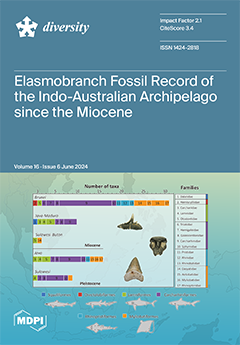Carbon (δ
13C) and nitrogen (δ
15N) isotopes were used to evaluate spatial, temporal, and interspecific differences in trophic relationships of four fish species (
Paralichthys dentatus,
Anchoa mitchilli,
Leiostomus xanthurus, and
Bairdiella chrysoura) in Maryland’s coastal bays. The δ
13C values for all species were more enriched in 2017 than in 2018, a year of higher-than-average rainfall that likely caused higher amounts of terrestrial carbon to enter the estuary. There were significant differences among species in the δ
13C values, with
L. xanthurus being the least depleted (−17.2‰ in 2017; −18.8‰ in 2018). Spatially, the δ
13C values of the species, particularly
P. dentatus and
B. chrysoura, were more depleted in the northern bays, which have a higher nutrient content and receive more freshwater inflow directly from tributaries, than the southern bays. The observed δ
13C values (−19.5 ± 0.2‰ to –17.2 ± 0.3‰), however, indicate that marine phytoplankton was the primary carbon source of the fishes. Overall,
A. mitchilli was the most enriched in δ
15N (13.0‰), and
L. xanthurus was the most depleted (10.2‰). δ
15N was more enriched in fish from the more human-impacted northern bays than in fish from the southern bays, though this might also have stemmed from the differences in the diet composition of the species in the northern and southern bays.
A. mitchilli had the highest trophic level, while
L. xanthurus and
P. dentatus had the lowest trophic levels. Niche breadth was widest in
L. xanthurus compared to the other fish species, suggesting a higher variability in diets among
L. xanthurus individuals, leading to specialized diets. There was a high niche overlap between
B. chrysoura,
A. mitchilli, and
L. xanthurus, which indicates they fed on similar prey resources.
Full article





